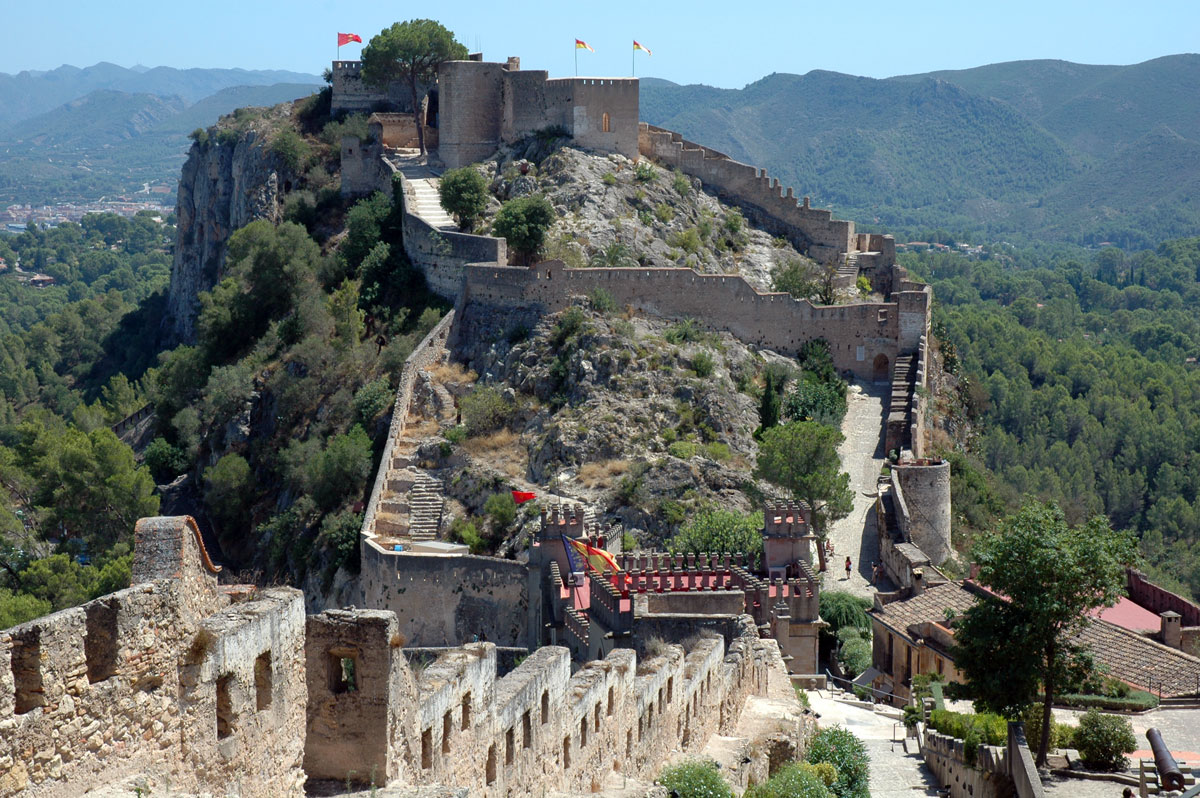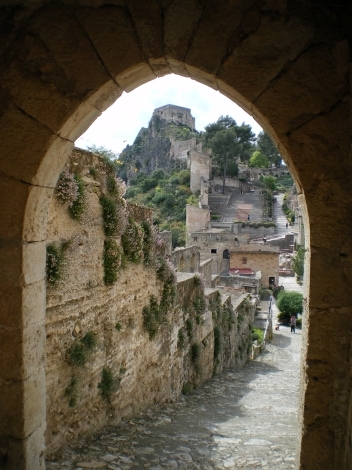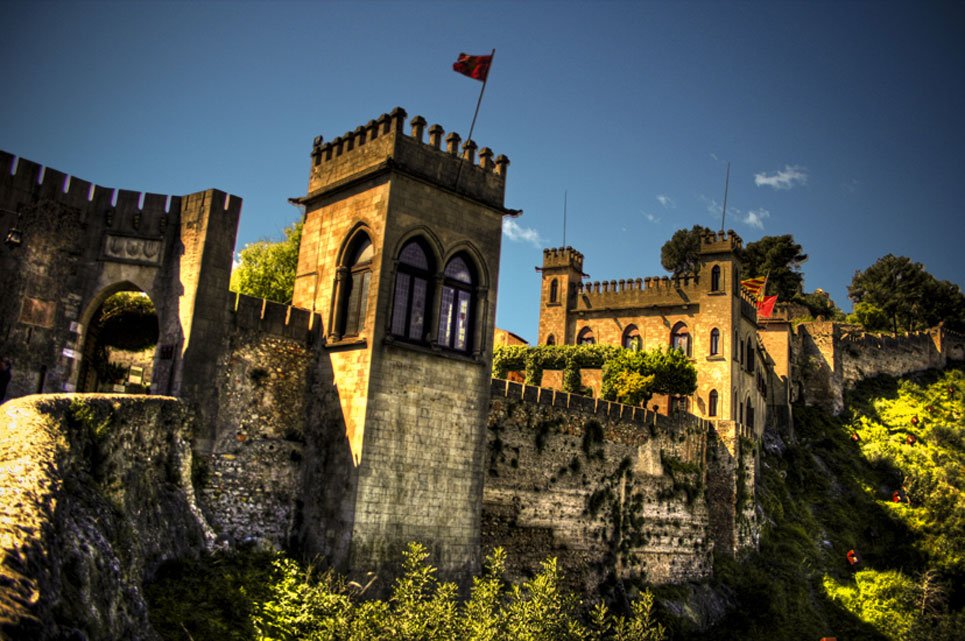
Xàtiva castle is located in the town of Xàtiva near Valencia. It is strategically located on the ancient roadway Via Augusta leading from Rome across the Pyrenees and down the Mediterranean coast to Cartagena and Cádiz. It is situated on the mountain known as Vernissa and from this, a series of defensive towers and walls embraced the city, the origin of the building is possibly Iberian, the oldest chronicles located Hannibal on his way to Sagunto, the Roman period is visible through the water reservoirs located in the highest part of the fort where we can appreciate the Islamic medieval period and the prevailing styles in the work. The castle can be divided into two parts: the Lower Castle is the oldest and its origin is believed to be before the arrival of the Romans and the Castillo Mayor, whose construction would begin with the Romans and later modified by the Arabs, Christians, etc.. These two fortifications are joined by pieces of wall of different times and they tore the walls that embraced the city. It has been declared a Historic-Artistic Monument and has been partially restored.

In 1092, the castle fell into the occupation of the Almoravid dynasty who were expelled in an uprising that took place in 1145. During this uprising, the castle was besieged by the Governor of Valencia, Marwan Abd-al-Aziz. In 1171, the Castle finally fell, along with the rest of the Levante coast, into the hands of the Almohads.
King James I of Aragon began his crusade there in the summer of 1239, finally capturing Xátiva on 22 May 1244, following a five-month siege. After submitting to the Christian monarch and signing the Treaty of Játiva the Moors handed over the smaller nearby Castle to James I, while they were allowed to continue occupying the larger castle for another two years based on the terms of the treaty.
After the two years had elapsed King James I of Aragon repopulated a large part of the town with Catalan and Aragonese settlers.

As you approach Xativa, a 40-minute drive west from Valencia, its castle appears to built on a ridge but, as you get closer you will see that its walls rise up from the town itself. As you wind up the narrow streets of the old town, you get tantalizing glimpses of the castle high above. Soon you reach the lower walls scaling the hillside, but you continue on a twisting road upwards. Just as you pass a church on your left, you will see the entrance to the Hotel Restaurant Mont Sant in one of the most incredible landscapes in the south of Valencia, below Xativa’s castle and surrounded by a great natural spot. Since it was opened in 1994, Hotel Restaurant Mont Sant is one the most significant hotels in Xativa and in the Valencian Community. The hotel was declared an Architectural and Artistic Monument and many relevant historical and cultural events have been held there. It’s 16.000 m2 of gardens, full of orange blossom and jasmine, as well as, the silence, the charm you can breathe in every corner of the place and the comfort of its facilities, make the hotel a peaceful paradise. The restaurant in the Hotel Mont-Sant is one of the most popular in the area due to its Mediterranean and fresh food so you will not be short of good food.
The Latin poet Silius Italicus(101-25BC) in his poem on the ll punic War refers to Saetabis celsa arce, Xátiva with its tall castle, so there is proof that a castle existed in Roman times, even though a castle stood here in earlier Iberian days. Its strategic value was due to its situation on the Via Augusta that began in Rome and crossed the Pyrenees and travelled down the Mediterranean coast before heading on to Cartagena and Cadiz. The grand structure you see these days standing watch over the town is a mixture of Iberian, Roman and Moorish influences and later Christian fortifications.
Xátiva castle with its 30 towers and four fortified gateways, must rate as one of the loveliest in the Valencian Community, not only because of its historic value but also because of a lot of thought and work has gone into its surroundings. Fountains, small orange groves, herb gardens that perfume the air, give you a sense of what life must have been like in an important garrison town. The fountains and gardens aren’t just modern improvements but were an important part of the Moorish culture. What is equally impressive is that standing on the high tower at either end of the long thin castle, you become aware of just how massive an undertaking it was to build such a structure in such an inaccessible place.
The town below the frowning castle walls is equally steeped in history. It was the birthplace of two popes of the Borgia [Borja] Clan. They were Calixtus lll and Alexander Xl, whose family virtually controlled the papal power for almost two hundred years and sired the infamous Lucretia. It was the first town in Europe to manufacture paper, during the time of the Moorish occupation, and even today in Morocco paper is still known as Xativi.
The streets themselves are like a splendid public gallery requiring no entrance fee. Mounted high on almost every wall of the old town, family names linger on in tiled plaques celebrating the lives of the saints. In your meanderings seek out the Placa del Mercat, a square on the cusp of moving from semi-tumbledown to modern and cobbled with so much charm. Set back in a corner is the Posanda del Pescado, its names spelt out in an intricate shell-like patterning with a fat fish dangling from a chain clenched in a Lion's mouth. Its beautifully carved doors and shutters are weathered with years of neglect.